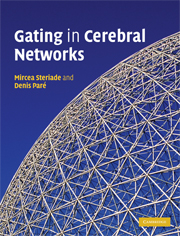Book contents
- Frontmatter
- Contents
- Preface
- Acknowledgements
- Chapter 1 Morphology and electroresponsive properties of thalamic neurons
- Chapter 2 Morphology and electroresponsive properties of neocortical cells
- Chapter 3 The amygdala
- Chapter 4 Rhinal and medial prefrontal cortices
- Chapter 5 Neuromodulation and state-dependent activities in forebrain neuronal circuits
- Chapter 6 Gating of signals in slow-wave sleep
- Chapter 7 Neuronal processes and cognitive functions in brain-active states of waking and REM sleep
- Chapter 8 Comparison of state-dependent activity patterns in the thalamocortical, hippocampal and amygdalocortical systems
- Chapter 9 Neuronal substrates of some mental disorders
- References
- Index
- Plate section
Chapter 6 - Gating of signals in slow-wave sleep
Published online by Cambridge University Press: 18 August 2009
- Frontmatter
- Contents
- Preface
- Acknowledgements
- Chapter 1 Morphology and electroresponsive properties of thalamic neurons
- Chapter 2 Morphology and electroresponsive properties of neocortical cells
- Chapter 3 The amygdala
- Chapter 4 Rhinal and medial prefrontal cortices
- Chapter 5 Neuromodulation and state-dependent activities in forebrain neuronal circuits
- Chapter 6 Gating of signals in slow-wave sleep
- Chapter 7 Neuronal processes and cognitive functions in brain-active states of waking and REM sleep
- Chapter 8 Comparison of state-dependent activity patterns in the thalamocortical, hippocampal and amygdalocortical systems
- Chapter 9 Neuronal substrates of some mental disorders
- References
- Index
- Plate section
Summary
We now discuss how external and internal signals are processed in the thalamus and cerebral cortex during the state of slow-wave sleep and during different types of anaesthesia that mimic this sleep stage. Basically, signals from the periphery are obliterated through synaptic inhibition within the thalamus and cannot be transferred to cortex, whereas corticocortical and corticothalamic circuits remain active despite disconnection from the external world. This dissociation explains why, in the absence of information from the external world, the behavioural state of slow-wave sleep is associated with processing of internally generated signals and even with synaptic plasticity. These processes may lead to consolidation of memory traces acquired during the wakeful state as well as to a form of consciousness expressed by dreaming mentation. However, prior to discussing these topics, this chapter will first describe the spontaneously occurring brain oscillations and neuronal firing patterns that characterize slow-wave sleep.
Brain oscillations during slow-wave sleep and anaesthesia in animals and humans
The three major types of brain rhythms, which appear in the state of slow-wave sleep in experimental animals and humans, are mainly generated as a consequence of the reduction in firing rates of brainstem reticular and basal forebrain activating neurons that project to the thalamus and cerebral cortex (see Chapter 5). This relation was observed by recording cellular activity in the upper reticular core and mesopontine cholinergic nuclei during the transition from wakefulness to slow-wave sleep.
- Type
- Chapter
- Information
- Gating in Cerebral Networks , pp. 127 - 180Publisher: Cambridge University PressPrint publication year: 2007



